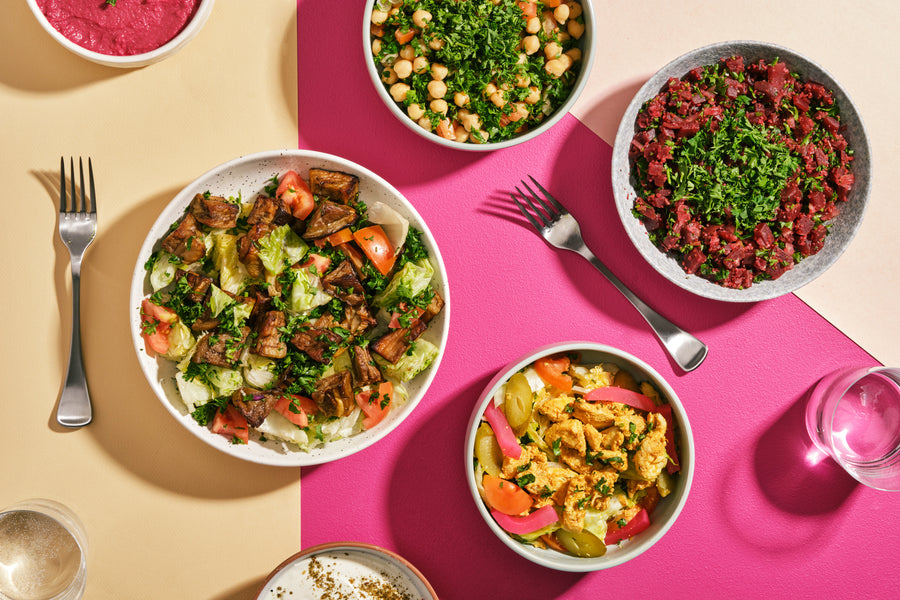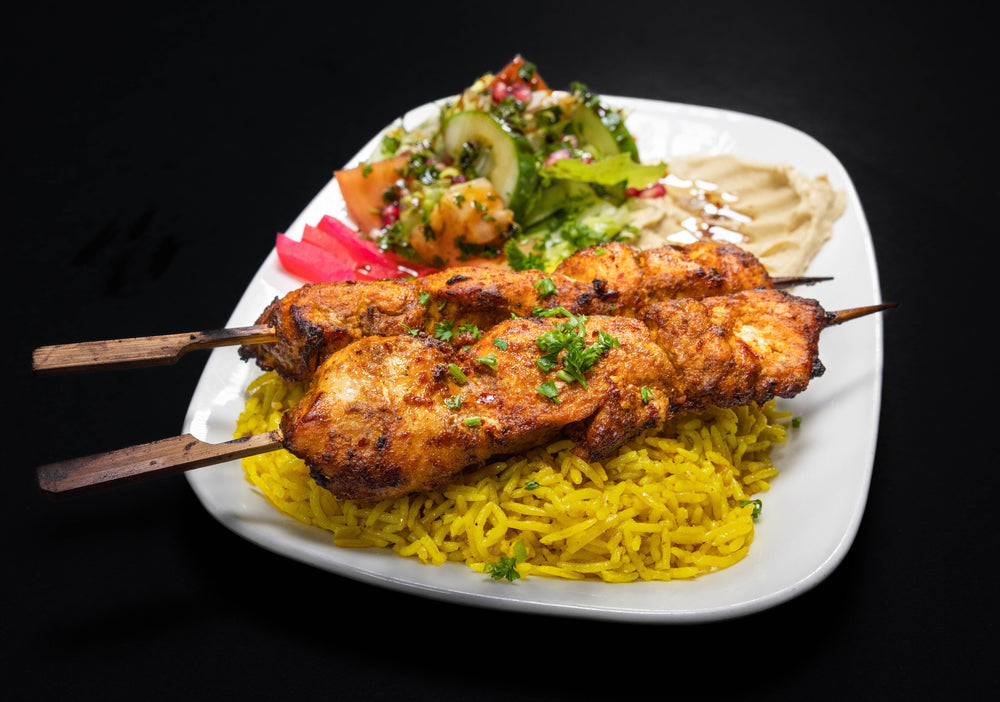Everything about the Rich Flavors and Traditions of Syrian Food: A Culinary Journey
Syrian food supplies an unique mix of tastes and practices that show its rich cultural history. With staple components like olive oil and garlic, together with a variety of spices, the meals are both varied and inviting. From the intricate preparation of kibbeh to the sweet allure of baklava, each facet of this culinary landscape discloses deeper stories. As one discovers the essence of these tastes, a higher understanding of public dining and event arises.
The Essence of Syrian Ingredients
The essence of Syrian active ingredients depends on their rich variety and ingrained social relevance. Influenced by the nation's different location and history, Syrian cuisine includes a wide variety of spices, herbs, and fresh fruit and vegetables. Staples such as olive oil, garlic, and lemon offer a foundation, while seasonings like cumin, sumac, and coriander add depth and intricacy to dishes.The usage of fresh herbs, consisting of parsley and mint, highlights the significance of seasonal active ingredients. Furthermore, the region's fertile soil returns a wealth of fruits and vegetables, such as pomegranates, eggplants, and tomatoes, which are indispensable to numerous recipes. Grains like bulgur and rice develop the base of lots of meals, highlighting the importance of these active ingredients in Syrian society. This blend of tastes mirrors not simply a culinary tradition yet additionally a tapestry of historic impacts, making Syrian active ingredients vital to recognizing its food's dynamic character.

Iconic Dishes of Syrian Food
Syrian cuisine is renowned for its legendary recipes that showcase an abundant tapestry of flavors and structures. Typical meze plates provide a variety of tiny meals that tantalize the palate, while hearty major courses offer gratifying centerpieces for meals (Afternoon Tea Vancouver). To complete the experience, a selection of scrumptious treats adds a pleasant note to the culinary trip
Typical Meze Plates

Hearty Main Courses
Hearty major programs act as the centerpiece of Syrian eating, showcasing a mix of tastes that mirror the country's rich cooking customs. Recipes such as kebab hindi, including marinated lamb skewers, and the popular mujaddara, a soothing mix of lentils and rice, highlight the use of fragrant spices and fresh ingredients. Another staple is the renowned kibbeh, made from bulgur wheat and minced meat, typically served in various kinds, consisting of baked, fried, or raw. Furthermore, the flavors of the land come to life in recipes like packed veggies, called mahshi, which are full of rice, meat, and herbs. These major courses not just please appetite yet likewise tell stories of family events and cultural heritage.
Scrumptious Treats Option
A wonderful selection of treats defines the wonderful side of Syrian food, using an alluring end to any kind of meal. Amongst one of the most popular confections are baklava, delicate layers of phyllo bread filled up with nuts and saturated in syrup, and maamoul, shortbread-like cookies usually packed with nuts or dates. Knafeh, a rich dessert made from thin noodle-like bread soaked in syrup and layered with cheese, is a preferred option, especially throughout festive events. Furthermore, the aromatic and wonderful rice pudding, understood as roz bil laban, offers a comforting surface. These delicious desserts not only showcase the area's cooking experience yet additionally show the cultural heritage of Syria, making them cherished treats in both dining establishments and homes alike.
Standard Cooking Strategies
Modern comforts have actually affected several cooking practices, conventional cooking methods continue to be necessary to Syrian cuisine. These methods often emphasize using fresh, seasonal components and concentrate on slow-moving food preparation to create abundant flavors. Methods such as barbecuing, braising, and stewing prevail, permitting the natural tastes of the active ingredients to radiate through.One remarkable strategy is the prep work of kibbeh, a dish made from finely ground meat and bulgur. It calls for experienced hand-rolling into numerous shapes and can be baked, fried, or offered raw. Additionally, the art of making bread, especially pita, is main to many dishes, commonly prepared in a standard stone oven.Preservation methods like pickling and fermenting also play a crucial role, enhancing the diversity of flavors located in Syrian recipes. These techniques not only reflect the area's agricultural heritage yet likewise promote a strong feeling of neighborhood via shared culinary methods.

The Function of Spices in Flavoring
Seasonings act as the heartbeat of Syrian cuisine, instilling recipes with complicated tastes and fragrant depth. Each seasoning plays a crucial duty, adding not only to preference however additionally to the social heritage of the region. Generally used seasonings consist of cumin, coriander, and sumac, each offering an one-of-a-kind profile that raises conventional dishes. For circumstances, cumin supplies heat and earthiness, while sumac adds a tangy illumination, enhancing the general dish.Syrian chefs commonly mix flavors to develop harmonious accounts, mirroring the complex balance of tastes that specify the cuisine. The usage of seasonings is not simply for seasoning; it additionally offers to protect food and enhance its dietary worth. This thoughtful consolidation highlights a deep understanding of the cooking arts, where flavors end up being important authors, conveying the abundant background and diverse impacts that characterize Syrian gastronomy. Inevitably, spices are crucial in crafting authentic and remarkable Syrian recipes.
Joyful customs and commemorative meals
Congratulatory meals in Syrian cuisine are marked by traditional feast dishes that show the country's rich culinary heritage. Unique occasions usually involve special rituals that enhance the public experience of eating. These customs not only honor the significance of the occasions yet also reinforce social and familial bonds.
Standard Feast Cuisines
When households collect to celebrate substantial celebrations in Syria, traditional feast recipes take spotlight, showcasing the rich culinary heritage of the area. These gatherings frequently include vibrant plates of mezze, consisting of hummus, baba ghanoush, and tabbouleh, which work as fascinating starters. The primary course normally highlights lamb or chicken, marinaded and prepared to excellence, often come with by fragrant rice pilaf or bulgur. One of one of the most beloved dishes is maqlooba, a layered rice meal with vegetables and meat, flipped upside down prior to offering. Sweets also play a vital function, with baklava and knafeh using a pleasant coating to the meal. Each dish not only thrills the taste buds but likewise shows the ingrained traditions and public spirit of Syrian culture.
Special Occasion Rituals
Special events in Syria are noted by rich routines that link food and festivity, reflecting the social importance of common events. Congratulatory meals typically consist of typical meals such as kibbeh, tabbouleh, and various smoked meats, prepared with care and shared amongst friends and family. During religious holidays like Eid al-Fitr and Eid al-Adha, family members collaborated to prepare special desserts like maamoul, symbolizing unity and pleasure. Weddings are especially fancy, featuring numerous courses and lively screens of hospitality. These occasions are not merely regarding food; they incorporate narration, music, and dancing, reinforcing social bonds and cultural heritage. With these routines, Syrians commemorate life's turning points, guaranteeing customs are passed down via generations, improving their cooking landscape.
The Significance of Sharing and Area
Sharing dishes is a fundamental facet of Syrian society, showing the ingrained worths of neighborhood and connection. In Syria, food is not just food yet a means of bringing individuals with each other. Pals and households gather around the table to enjoy standard recipes, cultivating bonds and Wedding Catering producing enduring memories. This public dining experience emphasizes friendliness, where hosts most likely to excellent sizes to ensure every guest really feels welcomed and nourished.The act of sharing food also signifies kindness and uniformity, strengthening social ties within areas and larger areas. During gatherings, it is usual for people to offer each various other, showcasing a spirit of togetherness that transcends individualism. Celebrations, whether tiny or big, are usually marked by the sharing of meals, where varied flavors and meals come with each other, reflecting the abundant tapestry of Syrian society. Appropriately, the relevance of sharing and area in Syrian cuisine is not only a cooking tradition however an important social method.
A Cooking Exploration of Syrian Sugary Foods
Commonly overshadowed by savory dishes, Syrian sweets hold a cherished area in the country's culinary heritage (Afternoon Tea Vancouver). These confections reflect the region's abundant background, blending flavors and methods from different cultures. Typical look at here desserts like baklava, with its layers of phyllo bread, nuts, and honey syrup, display the artistry associated with Syrian food preparation. Ma'amoul, a shortbread-like cookie loaded with nuts or dates, is frequently gotten ready for cheery events, symbolizing hospitality and celebration.Another beloved sweet is Knafeh, a useful reference pastry taken in syrup and split with cheese or lotion, supplying a delightful contrast of appearances. Syrians also appreciate a selection of fruit protects and syrups, commonly offered with tea or as component of a bigger spread during gatherings. These sugary foods not just satisfy the palate yet also act as a bridge between generations, protecting the traditions and stories of Syrian society through each mouth-watering bite
Often Asked Questions
What Are the Wellness Benefits of Conventional Syrian Foods?
The health and wellness advantages of typical Syrian foods consist of abundant nutrients from fresh veggies, vegetables, and entire grains. These active ingredients promote heart health, improve digestion, and give crucial vitamins, contributing to overall wellness and a well balanced diet regimen.
How Has Syrian Cuisine Developed For Many Years?
Syrian food has actually evolved substantially, affected by historic trade routes, cultural exchanges, and local accessibility of components. Standard recipes have incorporated contemporary tastes and methods while keeping their rich heritage, reflecting a varied culinary landscape.
Are There Vegetarian or Vegan Options in Syrian Food?
Syrian cuisine uses many vegan and vegan options, featuring recipes like falafel, tabbouleh, and stuffed grape fallen leaves. These meals highlight the area's rich agricultural heritage, showcasing fresh veggies, grains, and aromatic flavors in dynamic combinations.
What Beverages Set Well With Syrian Meals?
When taking into consideration drinks that match Syrian recipes, one could discover that mint pomegranate, ayran, and tea juice boost the dish's flavors. In addition, red white wine often sets well with the seasonings frequently discovered in these cuisines.
Exactly How Can I Recreate Syrian Meals in the house?
To recreate Syrian meals in the house, one need to explore genuine recipes, collect typical active ingredients, and utilize food preparation methods unique to the food. Trying out spices and discussion likewise improves the overall dining experience. Syrian cuisine is renowned for its renowned dishes that display an abundant tapestry of structures and tastes. Seasonings serve as the heart beat of Syrian cuisine, infusing dishes with complicated tastes and aromatic deepness. Congratulatory meals in Syrian cuisine are noted by traditional feast meals that reflect the nation's rich culinary heritage. Celebrations, whether huge or little, are commonly noted by the sharing of meals, where varied flavors and recipes come with each other, showing the abundant tapestry of Syrian society. Syrian food provides numerous vegan and vegan options, including dishes like falafel, tabbouleh, and stuffed grape leaves.